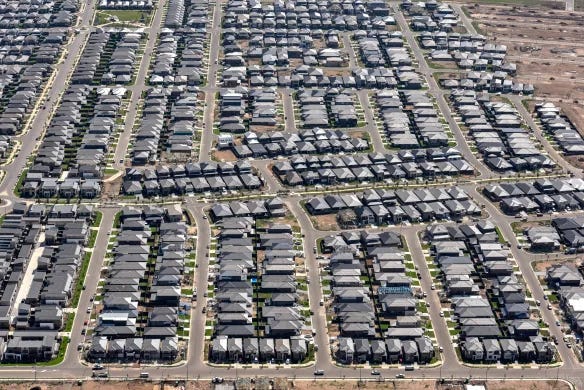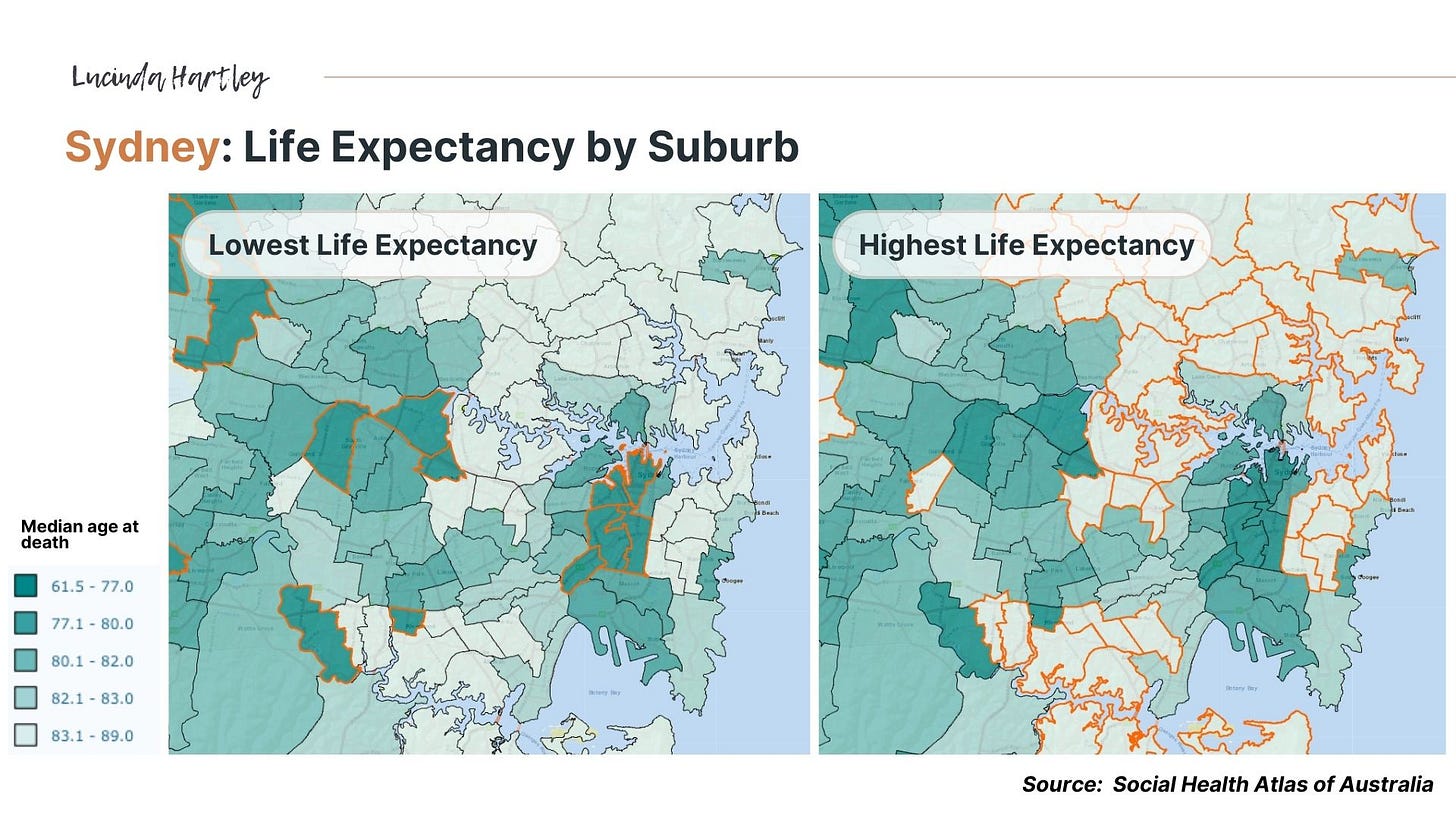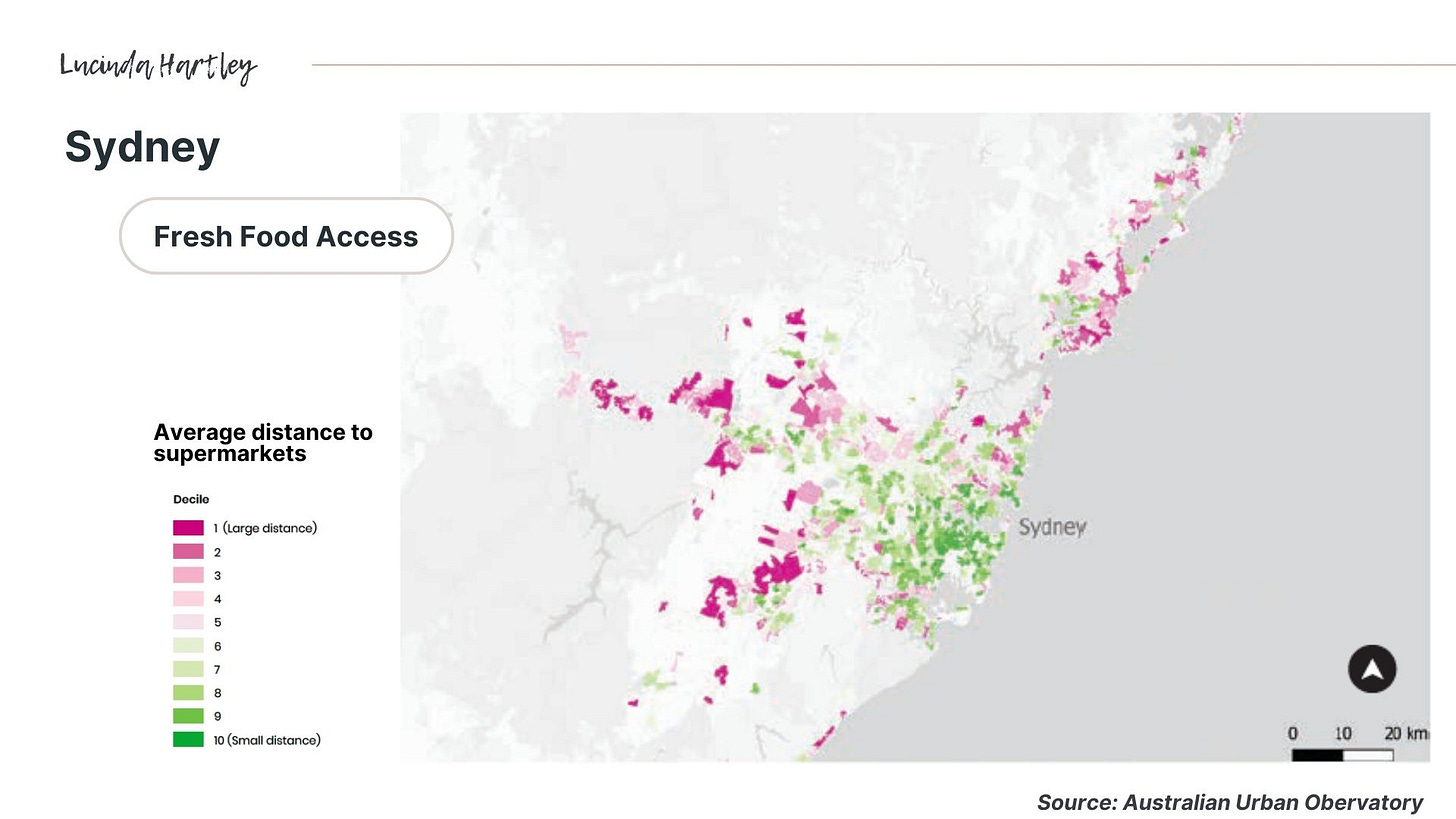When it comes to choosing a home we usually think about the number of bedrooms, the size of the backyard or the quality of the appliances - but not your life expectancy. However, the place you call home is one of the most significant factors in predicting longevity. In Australian Cities, a remarkable divide in life expectancy exists between different suburbs, where your postcode can add (or subtract) as much as a decade from your life. So it pays to choose wisely.
Below we delve into:
The life expectancy disparities across suburbs of Melbourne and Sydney, and how they compare.
The three reasons why this discrepancy exists, and
What we can do about it, including how technology, big data and AI are helping us pave the way for a healthier future.

1. Life Expectancy Disparities in Australian Cities
Every city has two sides of the tracks - north vs south, east vs west. In Australia’s largest city, Sydney, this divide is perhaps most strikingly exemplified by the disparities between its eastern and western suburbs. We know Sydney’s northern and eastern beach suburbs for their tree lined streets, coastal views, good services and transport (and price tag to match). While the growth areas to the West often grapple with less access to these amenities, a greater reliance on car transportation, and more recently challenges of urban heat. In the west, the temperature can be more than 10 degrees hotter and some of Western Sydney’s housing Estates in Penrith have been the hottest place on Earth, with temperatures peaking just under 50 degrees.
Data from the Social Health Atlas of Australia shows the difference between east and west could also mean as much as a decade of your life. Suburbs in the east and north have a much higher life expectancy than in the west.
In Melbourne the pattern is similar, where the well serviced, well established leafy green suburbs to the East have life expectancy outcomes that far exceed the Western suburbs. Like Sydney, Melbourne’s western suburbs are hotter, likely to be more car reliant, and have less access to amenities.
The exception to the east-west divide in both cities is the CBD areas, which have overall much younger populations compared with suburban areas, as well as a higher proportion of accidents and higher concentration of homeless shelters which pulls the overall average down.
2. Can your suburb make you sick?
Let's explore three major factors contributing to these differences in life-expectancy:
Walkability
Local Amenities (particularly fresh food) and
Social connection
Walkability
One crucial factor affecting life expectancy is walkability. The eastern suburbs of Melbourne and Sydney were established before personal car ownership was a thing, so communities are designed with walkable streets, often around transport hubs.
Newer suburbs in the west are connected to freeways rather than railways, and assume that people will drive. While public transport has been planned for the West, in many instances this has been delayed and delivered years or decades ahead of residential development.
The maps below show the relative walkability of Melbourne and Sydney according to Walkscore, an index that assigns a numerical walkability score to any address which assigns a value between 0 and 100 for how easy it is to walk.
Access to Fresh Food
Access to local amenities also plays a pivotal role for wellbeing. A healthy neighbourhood is one that contains all of the amenities required to support daily life within walking distance. This local neighbourhood concept is often referred to as a 20 minute neighbourhood or the 15 minute city.
“If 20-minute neighbourhoods existed across Melbourne, it could reduce travel by nine million passenger kilometres and cut Melbourne’s daily greenhouse gas emissions by more than 370,000 tonnes.” — Plan Melbourne 2017-2050
With regards to life expectancy, the most important of these is fresh food.
In the eastern suburbs of Melbourne and Sydney, residents often have better access to grocery stores, farmers' markets, and a wider variety of healthy food options. In contrast, the western suburbs frequently suffer from food deserts, areas with limited access to affordable, fresh, and healthy food, but also comparatively higher levels of access to fast food. This lack of access can lead to poor dietary habits, contributing to chronic health issues and a shorter life expectancy.
The maps below show the relative availability of supermarkets, in analysis by the Australian Urban Observatory.
Social Connection and Loneliness
Social connection is another significant factor in predicting life expectancy. The quality of these relationships can have benefits for both individuals and society .
“Good social relationships and connections with people around us are vitally important to individual well-being. This is important to national well-being because the strength of these relationships helps generate social values such as trust in others and social cooperation between people and institutions within our communities” (Evans 2015).
In the eastern suburbs of Melbourne and Sydney, communities are longer established, with stronger social networks as well as a high concentration of community organisations, and resources for mental health support. The suburb layout also has a significant role to play - walking and catching public transport help you connect with strangers, an important part of feeling less lonely.
Car dependence is also a factor driving increased social isolation in the West, particularly for single car families where one spouse takes the car to work and the other (typically women) are at home and unable to easily get to shops and amenities. Teenagers, older citizens and people with mobility needs are also much more likely to experience social isolation in suburbs where there are less transport and amenity options.
3. Technology and a Path to Understanding and Improvement
The geographic divide and corresponding health outcomes is an issue that affects all Australians and is a matter for significant policy concern. So far planning provisions have helped to ensure that supermarkets and a basic level of amenity is put in place in new housing developments, but the walkability and transit provision is still lacking.
A lack of information about suburb health inputs has also been lacking. While we measure the outcomes (hospital visits, life expectancy), our understanding of the inputs (walking, amenities socal connection) and the various ways these complex social factors manifest in different locations has, to date, been poorly understood at a local level.
Big data and emerging AI tools can offer assistance to help analyse and understand these disparities - whether that relates to visitation, walkability, food access and amenities.
Beyond data emerging technology - driverless cars, build to rent housing models and home-delivery services are taking steps to address amenity and transport inequalities - although these do not go far enough to address some of the fundamental livability concerns - like walkability.
Still work to do
The reality is that we have work to do. Life expectancy inequalities across suburbs has existed for decades, the challenge is that in recent years as cities have expanded, we have not got close to narrowing the gap. Policy, infrastructure and our own housing choices need a greater emphasis on health and happiness, and not just efficiency.










